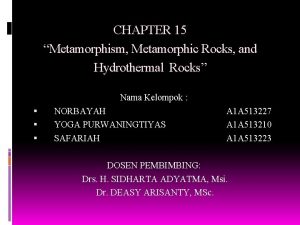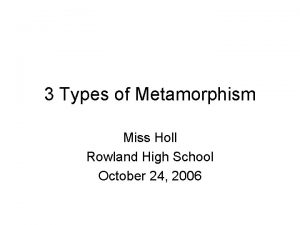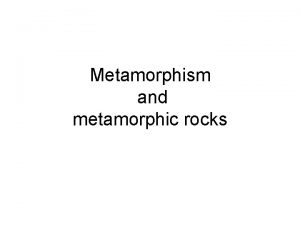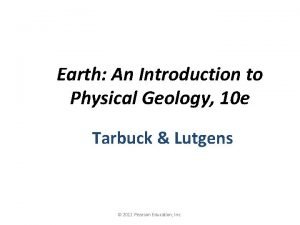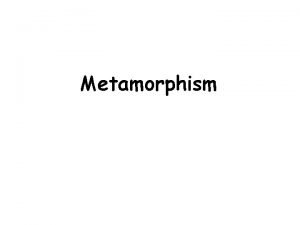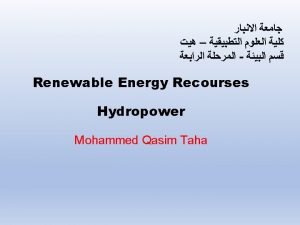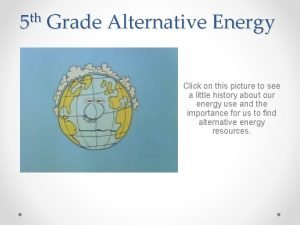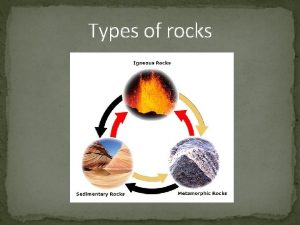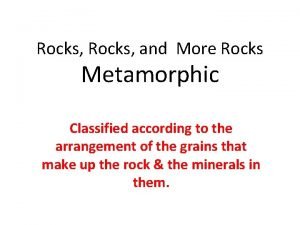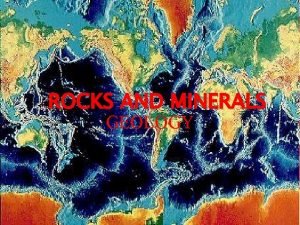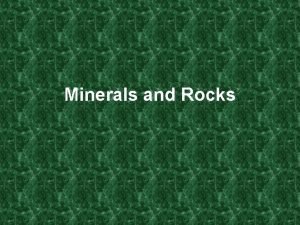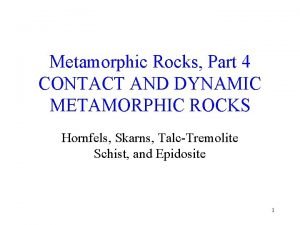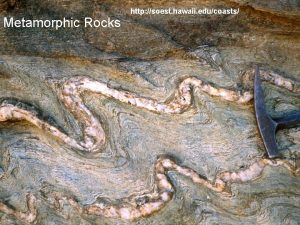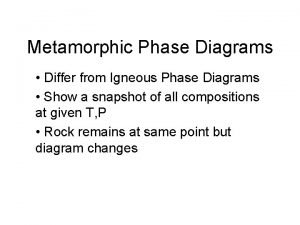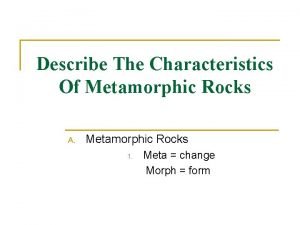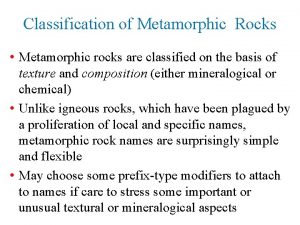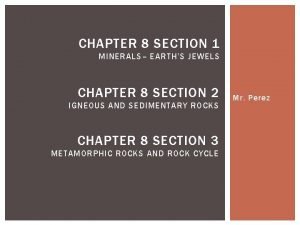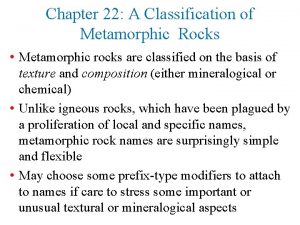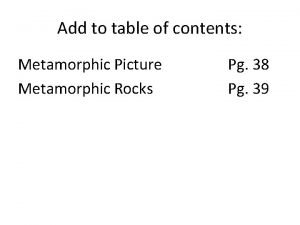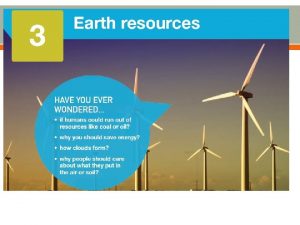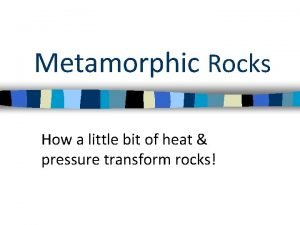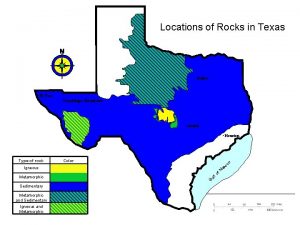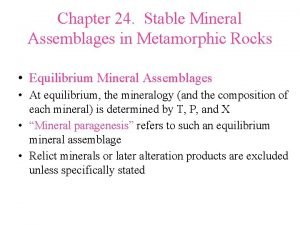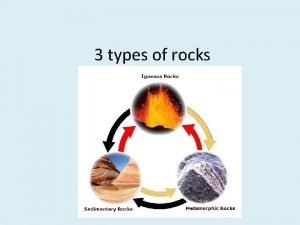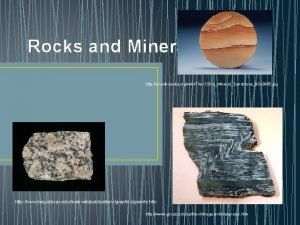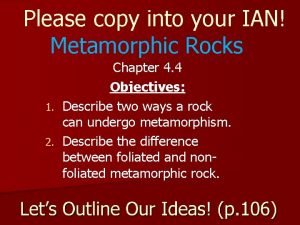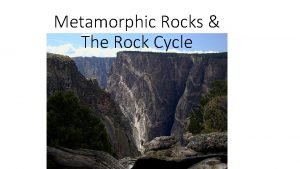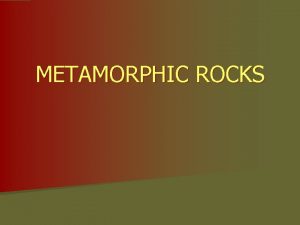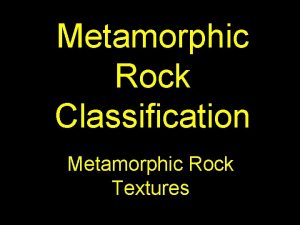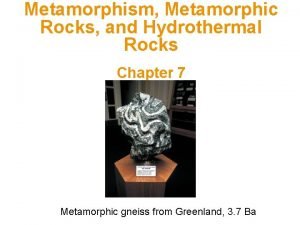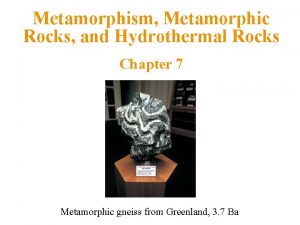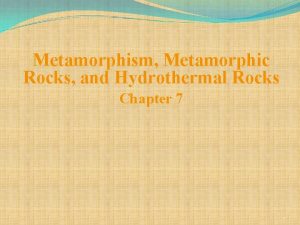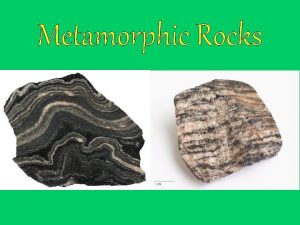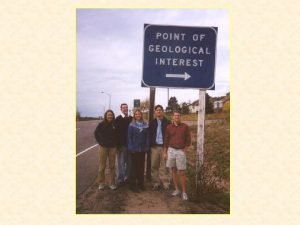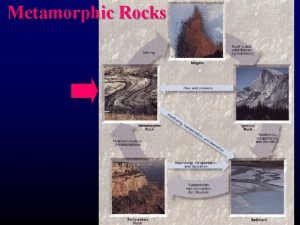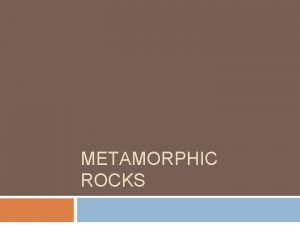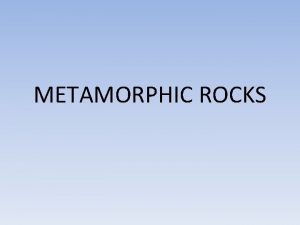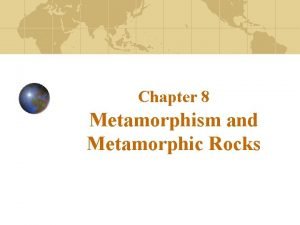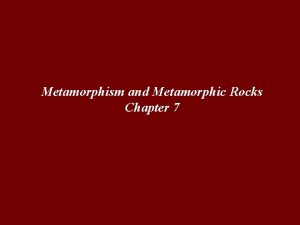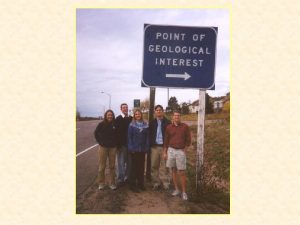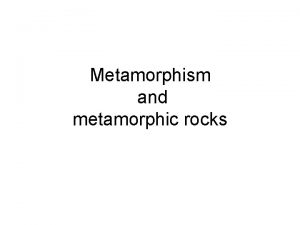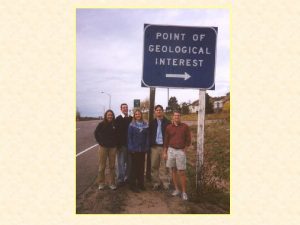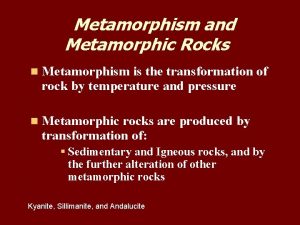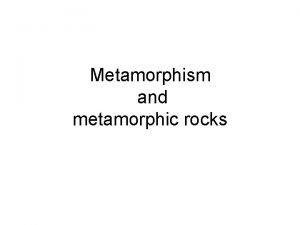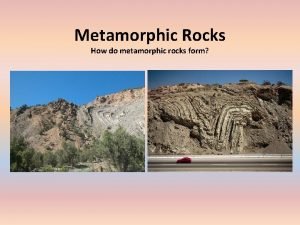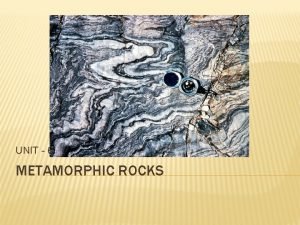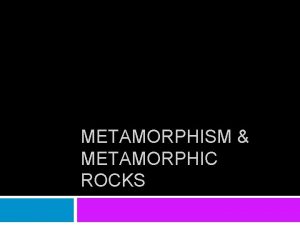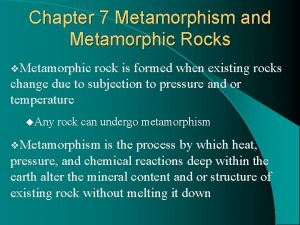Chapter 7 Metamorphism Metamorphic Rocks and Hydrothermal Rocks
















































- Slides: 48

Chapter 7 Metamorphism, Metamorphic Rocks, and Hydrothermal Rocks Copyright © The Mc. Graw-Hill Companies, Inc. Permission required for reproduction or display.

Metamorphism What happens to rocks that are deeply buried but are not hot enough to melt? § They become metamorphosed! Metamorphism refers to changes to rocks that occur in the Earth’s interior. § Changes may be new textures, new mineral assemblages, or both. § These changes occur w/o the rock melting.

Factors Controlling the Characteristics of Metamorphic Rocks § § § Composition of the Parent Rock Temperature Pressure Fluids Time

CO. 07

Fig. 07. 01

Composition of the Parent Rock § The parent rock controls the mineral content of the metamorphic rock § A limestone composed of Ca. CO 3 cannot metamorphose into a silica-rich rock.

Temperature § Geothermal Gradient § The deeper a rock is beneath the surface, the hotter is will be.

Pressure § Confining pressure - equally on all surfaces. § Lithostatic pressure – pressure exerted on buried material that forces grains closer together and eliminates pore space. § Pressure gradient – increase in lithostatic pressure with depth, ~1, 000 atmospheres per 3. 3 km.

Pressure § § Stress Differential Stress Compressive Stress Shearing

Fig. 07. 02

Fig. 07. 03

Fig. 07. 04

Pressure § Foliation– describes rock with a planar texture. Slaty – rock splits easily along planes Schistose – visible platy minerals in planes Gneissic – light and dark banding of minerals

Fig. 07. 05

Fig. 07. 06

Fig. 07. 14

Fluids § Water is thought to help trigger metamorphic chemical reactions

Time § A recent calculated growth rate for garnet crystals taken from a metamorphic rock in Vermont = 1. 4 mm per million years

Two most common types of Metamorphism § Contact Metamorphism § Regional Metamorphism

Contact Metamorphism § High temperature is dominant factor and confining pressure usually low. Typically nonfoliated due to lack of differential stress. shale (mica) hornfels (fine-grained, unfoliated metamorphic rock) basalt (amphibole) hornfels quartz sandstone quartzite limestone marble

Fig. 07. 08

Regional Metamorphism § Majority of metamorphics are produced this way by baking at considerable depth underground (>5 km). Typically 300 to 800°C. Almost always foliated. The differential stress is due to tectonism, the constant movement and squeezing of the crust during mountain building. basalt low temp greenschist (chlorite, actinolite, and Na-rich plagioclase) basalt high temp amphibole schist (hornblende, plagioclase feldspar, and maybe garnet)

Fig. 07. 09

Fig. 07. 10

Fig. 07. 11

Fig. 07. 12

Fig. 07. 13

Fig. 07. 14

Fig. 07. 15

Classification of Metamorphic Rocks § Foliated or not § If not foliated, named on composition § If foliated, determine type of foliation, then modify name based on composition

Fig. 07 a

Fig. 07 b

Table 07. 01

Table 07. 02

Plate Tectonics and Metamorphism § Heat is the most variable of the controlling factors of metamorphism § In subducting environments, heat is provided by: 1. normal overburden/geothermal gradient. 2. friction along the collision zone. 3. feeding of volcanic-plutonic arc complex. § Result: study isotherms to understand why different metamorphic rocks form in two places at the same depths, and from the same parent material.

Fig. 07. 16

Hydrothermal Processes § Hydrothermal Activity at Divergent Plate Boundaries – Black Smokers As seawater moves through the crust, it dissolves metals and sulfur from the crustal rocks and magma. When the hot, metal-rich solutions contact seawater, metal sulfides are precipitated in a mound around the hot spring. Metals in these rift-valley hot springs are predominantly iron, copper, and zinc (w/ smaller amounts of manganese, gold, and silver).

Fig. 07. 17

Black smokers

Hydrothermal Processes § Hydrothermal Activity at Divergent Plate Boundaries During metamorphism the ferromagnesian igneous minerals, olivine and pyroxene, become converted to hydrous (water-bearing) minerals such as amphibole. The hydrous minerals may eventually contribute to magma generation at convergent boundaries. After oceanic crust is subducted the minerals are dehydrated deep in the subduction zone.

Fig. 07. 22

Hydrothermal Processes § Metasomatism – metamorphism coupled with the introduction of ions from an external source.

Fig. 07. 19

Hydrothermal Processes § Hydrothermal Rocks and Minerals 1. Form from hot water given off by a cooling magma. 2. Or, also produced by ground water heated by a pluton and circulated by convection. § Typically form vein deposits as ions leave water and cake onto walls of fractures. § Disseminated deposits from by depositing small grains of the ore minerals as the water percolates through the grains of the rocks.

Fig. 07. 21

Hydrothermal Processes § Sources of Water 1. Surface-derived ground water can only penetrate to a limit. 2. Plate tectonics can account for water at deeper levels in the lithosphere as seawater trapped in the oceanic crust can be carried to considerable depths through subduction. The hydrous minerals in basaltic crust provide water through recrystallization when the rocks get hot.

Fig. 07. 22

Table 07. 03
 Hydrothermal metamorphic rocks
Hydrothermal metamorphic rocks Miss holl
Miss holl Non foliated metamorphic rocks
Non foliated metamorphic rocks Earth science
Earth science Hydrothermal metamorphism
Hydrothermal metamorphism Igneous vs sedimentary or metamorphic
Igneous vs sedimentary or metamorphic Igneous metamorphic sedimentary
Igneous metamorphic sedimentary Metamorphic rocks cycle
Metamorphic rocks cycle Igneous rock
Igneous rock Chapter 6 sedimentary and metamorphic rocks
Chapter 6 sedimentary and metamorphic rocks Key concept summaries answer key
Key concept summaries answer key Disadvantages of geothermal energy
Disadvantages of geothermal energy Naturally occurring areas of hydrothermal resources
Naturally occurring areas of hydrothermal resources Naturally occurring areas of hydrothermal resources
Naturally occurring areas of hydrothermal resources Thermarces cerberus
Thermarces cerberus Meta - change morph -
Meta - change morph - Parent rock.
Parent rock. Metamorphic rocks with a layered or banded look are called
Metamorphic rocks with a layered or banded look are called Chegg
Chegg Characteristics of metamorphic rocks
Characteristics of metamorphic rocks Uses of metamorphic rocks
Uses of metamorphic rocks Characteristics of metamorphic rocks
Characteristics of metamorphic rocks Venn diagram of intrusive and extrusive igneous rocks
Venn diagram of intrusive and extrusive igneous rocks Dynamic metamorphic rocks
Dynamic metamorphic rocks Metamorphic
Metamorphic Metamorphic rocks in hawaii
Metamorphic rocks in hawaii Metamorphic rock phase diagram
Metamorphic rock phase diagram Formation of metamorphic rocks
Formation of metamorphic rocks Metamorphic rock characteristics
Metamorphic rock characteristics Classification of metamorphic rocks
Classification of metamorphic rocks Metamorphic rocks drawing
Metamorphic rocks drawing Foliated definition
Foliated definition Metamorphic rocks summary
Metamorphic rocks summary Table of contents picture
Table of contents picture Worded equation for photosynthesis
Worded equation for photosynthesis Glacial deposits
Glacial deposits Foliated rocks
Foliated rocks Sedimentary rocks in texas
Sedimentary rocks in texas Biotite
Biotite Classification of rocks
Classification of rocks Metamorphic rocks characteristics
Metamorphic rocks characteristics Schist rock
Schist rock Metamorphic rocks properties
Metamorphic rocks properties Marble rock foliated
Marble rock foliated What is grains
What is grains Metamorphic rocks
Metamorphic rocks Metamorphic rocks
Metamorphic rocks Common metamorphic rocks
Common metamorphic rocks Student found a metamorphic rock in the campsite
Student found a metamorphic rock in the campsite
